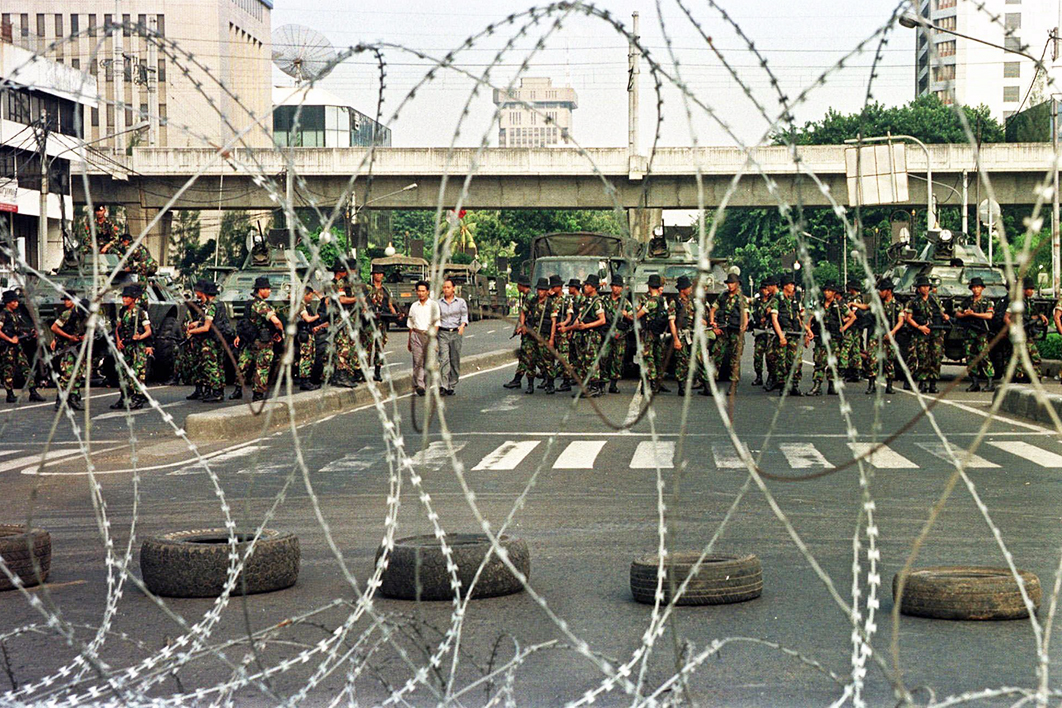These days, the sudden collapse of a democracy — whether it’s after a military coup or a civilian leaders’ seizure of “emergency powers” — is kind of like a plane crash: it’s all the more shocking precisely because it’s become relatively rare. Thanks to a global wave of populism and bestselling paperbacks by political scientists, we pretty well understand that the slow erosion of democratic norms and institutions at the hands of elected leaders is typically how democracy dies in the twenty-first century.
As Dan Slater and Joseph Wong remind us in their new book, Development to Democracy: The Transformations of Modern Asia, authoritarianism also tends to die not with a bang but with a whimper. They set out to understand the political effects of economic transformations in Asian countries where state-building and rapid economic modernisation have been the mutually reinforcing goals of government.
This “developmental Asia,” as the authors call it, has borders that are stark but porous: no South Asian government has driven capitalist industrialisation seriously enough to be considered part of it, but former laggards like China, Vietnam and Myanmar have been able to enter after socialist economics proved a dead end.
The starting point of Development to Democracy is the observation that democratisation in developmental Asia has not been prompted by a perception among authoritarian elites that their regime faces a revolutionary threat or a looming collapse. Rather, these elites have developed a “well-founded expectation of continued stability and even continued outright victory after democratisation takes place.”
The epitome of “democratisation through strength,” as Slater and Wong call this process, was Taiwan’s transition from one-party rule in the 1980s and 1990s. Facing rising demands for reform from civil society, a growing Taiwanese-nationalist opposition and the end of the cold war, the ruling Kuomintang lifted martial law and introduced contested elections. The gamble paid off not just for Taiwan’s people — who today enjoy the highest-quality democracy in Asia — but also for the Kuomintang itself, which now forms half of a stable two-party system alongside the Democratic Progressive Party, which has its roots in the opposition movement of the 1980s.
What we should want, Slater and Wong imply, is for authoritarian regimes to act like the Kuomintang or its contemporaries in South Korea: concede from a position of strength, just past the apex of their power and popularity, giving the regime’s legatees the opportunity to compete in free and fair elections by boasting they not only made the country rich but also made it free.
Democratisation through strength is Asia’s signal contribution to the global political landscape, having given birth to robust liberal democracies in Japan, Taiwan and South Korea, and to a flawed but stable electoral democracy in Indonesia. Yet it also produced failed experiments with democracy in Thailand and Myanmar, and has been resisted in Singapore, China, Indochina and — until only recently — Malaysia.
Despite the book’s concern with the relationship between economic development and democratisation, Slater and Wong aren’t offering warmed-over modernisation theory: the puzzle they seek to explain is why “levels of economic development are not clearly correlated with levels of democracy in developmental Asia.”
In theory, the legacies of authoritarian developmentalism make it safe for regimes to concede democratic reforms. Having transformed the living standards of the average voter, these regimes believe that their popular legitimacy will transfer to their own party or its successor(s) in free and fair elections. The poverty reduction and social safety nets they initiated — as well as their repression of the left — means that they need not worry about distributive conflicts spiralling out of control once democracy arrives.
This “victory confidence” and “stability confidence,” per the book’s shorthand, are needed for regimes to democratise, but they don’t on their own provide the impetus for reform. Instead, Slater and Wong emphasise the contingencies that come into play when pressures for reform from below interact with the regime’s perceptions of its own strength.
Reform pressures can come in many forms, and can come simultaneously. A regime can be confronted with signals of declining legitimacy, including gains by opposition parties in stage-managed elections, the defection of middle-class groups to anti-regime movements, or nudges from democratic security benefactors (essentially, the United States).
As the case of Malaysia shows, a regime’s ability to read the signs of its incipient decline makes all the difference to its capacity to engineer a transition to democracy on its own terms. In 1998, seventeen years into his economically successful twenty-three-year stint as prime minister, Mahathir Mohamad chose to repress rather than accommodate the reformasi movement that emerged after he sacked and prosecuted his politically ambitious finance minister Anwar Ibrahim amid a dispute over the Asian financial crisis.
Mahathir’s party, UMNO, endured as the cornerstone of the Barisan Nasional government for another twenty years, but electoral gerrymandering masked a gradual erosion in its popularity. The party’s decay reached its terminus in the extravagantly corrupt prime ministership of Najib Razak, who oversaw Barisan Nasional’s first-ever election loss in 2018. The victor in that election was an opposition coalition led by Mahathir, who’d become embittered in his retirement. Najib is in jail, and after a thrashing in last November’s general election the party has been reduced to a supporting act in a coalition government led by none other than Anwar Ibrahim.
Singapore — the place where modernisation theory goes to die — could go either way. The People’s Action Party, or PAP, is exceptionally well equipped to anticipate the signs of decline and position itself to thrive in a democratic system. It has a luminous track record of economic development and competent governance. Tightly controlled elections and grassroots “consultation” processes give it regular health checks on its popular support.
But the PAP reckons those feedback mechanisms haven’t set off enough alarm bells to incentivise it to embrace reforms. Slater and Wong suggest the PAP is taking a risky path: the slump in its vote in the 2020 general election might be written off as a pandemic-era aberration, but if the government underperforms in polls due by 2025 — by which time a leadership transition is also due — the PAP will be at a fork in the road: democratise from a position of dominance or risk going down the UMNO route.
China has a quite different set of problems. Conceding to demands for political reform in 1989 would have represented what Wong and Slater call “democracy through weakness” — the precipitous collapse of an authoritarian regime — to a degree never before witnessed in developmental Asia. With China’s turn to capitalism having yet to generate broad-based prosperity, and the traumas of the Mao era still fresh in elites’ memories, a fragmented and poorly institutionalised Communist Party regime couldn’t be confident of maintaining power or stability in a more competitive system. Too weak to concede, it cracked down violently.
The tragedy of today’s China, by contrast, is that the regime has become too good at repressing dissent to receive reliable signs that its own legitimacy, and political stability more broadly, would be better served by conceding reforms. Without even the ersatz electoral processes that marked East Asia’s other developmental authoritarian regimes, or their conditional tolerance of liberal civil society, Xi Jinping’s party-state is trapped in a black box of its own making, so paranoid about its hold on power that it can’t tell the difference between politically innocuous forms of civic activity and bona fide threats to its rule.
The idea of democracy as something vouchsafed by self-interested elites doesn’t readily gel with our more romantic ideas about how political freedom is won. The notion that democracy can be fortified by the socioeconomic legacies of dictatorship can be hard to swallow, too. But Slater and Wong’s work is part of a growing body of scholarship that analyses democracy not as the outcome of a zero-sum contest between authoritarian incumbents and “people power” movements but as a product of intra-elite pacts.
Slater and Wong’s book doesn’t break new ground in terms of fresh interviews or archival research. It’s a drawing together of their own and other scholars’ work into a big-picture framework for understanding the political economy of democratisation in East Asia — one that is compelling in its analysis and thought-provoking in its implications for how governments and civil society can support democracy across the world.
Fitting democratisation — an intrinsically complex and contingent process — into one neat explanatory framework has its risks, of course. While Slater and Wong stress the critical role that popular pressures put on regimes in developmental Asia to reform political systems, I suspect that some country experts and scholars of social movements will feel that they overstate how much room for manoeuvre Asia’s authoritarians actually had once pressure for reform grew.
Even in the exemplary cases of Taiwan and South Korea, sustained popular protest presented elites with the choice between reform or a campaign of repression that may well have triggered greater unrest. Different observers look at the same set of facts and ask: did these regimes jump, or were they pushed?
And for a work so explicitly grounded in theories of the relationship between socioeconomic and political change, I was surprised by the minimal discussion of the ambiguous role middle classes have played in both demanding democracy and sustaining it after experiments in “democratisation through strength” are launched. Witness the highly problematic role of Thailand’s middle classes in its post-Thaksin politics, or how Indonesia’s intra-middle-class culture wars are eroding the quality of democracy there.
Slater and Wong could have enriched their analysis with more serious consideration of how popular preferences and agency augment the elite machinations they examine. After all, the middle class needs “victory confidence” and “stability confidence” too.
Yet my familiarity with Indonesia predisposes me to agree with Slater and Wong’s emphasis on the self-interested calculations of elites as a decisive factor in the emergence of durable democracies. While profound political change in Indonesia was almost inevitable once protests and riots threatened to make the country ungovernable by May 1998, the experiment with democratic reforms in the years thereafter was an “inside job” overseen by New Order holdovers. Slater and Wong are on solid ground when they observe that Indonesian democracy has survived against the odds in no small part because the old regime’s elites were assured of their ability to thrive in the new system.
But as Thailand and Myanmar make clear, democratisation through strength is a “reversible experiment” that doesn’t always bear fruit for those running it. Attempts to democratise through strength collapsed in Thailand (after Thaksin) and in Myanmar (after the National League for Democracy’s landslide election victories) because the conservatives who oversaw liberalisation realised they couldn’t effectively compete in the new system.
So what do we do with the insight that an essential precondition for democracy to take root in Asia has been authoritarian elites’ belief that democratisation won’t spell their political obsolescence?
Slater and Wong aren’t shy about taking their arguments to their logical conclusions. As they acknowledge, “one way to interpret the argument and evidence offered in this book is that democracy should only be pursued through strength.” They reject that sweeping idea, noting that it is possible for durable democracy to be born of people power movements.
Yet evidence from developmental Asia suggests that, on the probabilities, “by laying a stronger foundation for eventual stable democratic transition, gradual authoritarian strengthening is generally a preferable outcome to sudden and total authoritarian collapse” and the often-brittle democracies that emerge from the ashes.
For this reason, “we” — presumably, Western academics and policymakers — “should be looking at authoritarian regimes through lenses other than the standard lens of ‘democracy promotion.’” Instead, “authoritarian regimes that make genuine collective efforts to promote economic development, improve popular welfare, and build more predictable and durable political institutions should be offered the international community’s conditional encouragement rather than unrelenting pressure.”
As Asia feels the chill of a new cold war, it’s perhaps apt that Slater and Wong strike a retro note about the importance of encouraging state-building and development and hoping that, with a bit of luck, democracy might emerge as a side-effect. But their prescription seems oddly less relevant to Asia than to other parts of the world; indeed, it probably already describes what Western governments are doing in the region. Western aid programs and private foundations might still pay the bills for liberal civil society across developing Asia — supporting the “demand side” of the democratisation equation — but when it comes to top-level government engagement, Western policy already reflects the realpolitik that competition for influence with China demands of them.
Slater and Wong are less explicit about what their arguments offer to opposition parties and civil society. But the implication is that any struggle for change ought to prioritise reassuring authoritarian elites about their prospects in a democratic system. Perhaps one of this book’s most important contributions is to leave us with the unanswered question of how movements for democracy might thread that particular needle. •
From Development to Democracy: The Transformations of Modern Asia
By Dan Slater and Joseph Wong | Princeton University Press | $62.99 | 368 pages




